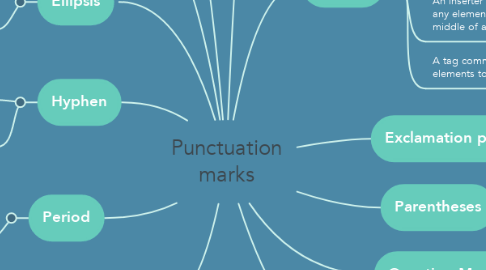
1. Apostrophe
1.1. As a substitute for a missing letter or letters
1.1.1. cannot = can't
1.2. to show the possessive case
1.2.1. Jane's room
1.3. and in the plural of letters
1.3.1. a's
2. Dash
2.1. A dash is used to separate parts of a sentence.
2.1.1. The dash is also known as an "em dash" because it is the length of a printed letter m — it is longer than a hyphen.
3. Ellipsis
3.1. An ellipsis (three dots) indicates that part of the text has been intentionally been left out.
3.1.1. 0, 2, 4, ... , 100
4. Hyphen
4.1. used between parts of a compound word or name.
4.1.1. The sixteen-year-old girl is a full-time student.
4.2. to split a word by syllables to fit on a line of text.
5. Period
5.1. A period is used to note the end of a declarative sentence.
5.1.1. I see the house.
6. Quotation marks
6.1. used at the beginning and end of a phrase to show that it is being written exactly as it was originally said or written.
6.1.1. She said, "Let's drink."
7. Colon
7.1. A colon is used before a list or quote.
7.1.1. There are many punctuation marks: period, comma, colon, and others
7.2. A colon is used to separate hours and minutes.
7.2.1. The time is 2:15.
7.3. A colon is used to separate elements of a mathematical ratio.
7.3.1. The ratio of girls to boys is 3:2.
8. Comma
8.1. A comma is used to separate phrases or items in a list.
8.1.1. She bought milk, eggs, and bread.
8.2. Together with a coordinating conjunction, a comma links coordinate (equal) elements in a sentence
8.3. An inserter comma is used before and after any element that is inserted into the middle of an independent clause.
8.4. A tag comma is used when adding certain elements to the end of a sentence.
9. Exclamation point
9.1. An exclamation point is used to show excitement or emphasis.
9.1.1. It is cold!
10. Parentheses
10.1. to separate explanations or qualifying statements within a sentence
10.1.1. This sentence (like others on this page) contains a parenthetical remark.
11. Question Mark
11.1. A question mark is used at the end of a question.
11.1.1. When are we going?
12. Semicolon
12.1. A semicolon separates two independent clauses in a compound sentence.
12.1.1. Class was canceled today; Mr. Smith was home sick.
12.2. A semicolon is also used to separate items in a series
12.2.1. Relatives at the reunion included my older brother, Bob; my cousin, Art; and my great-aunt, Mattie.
